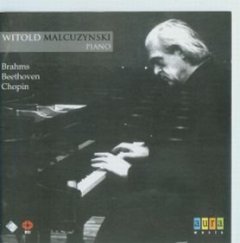Witold Malcuzynski - Brahms Piano Concerto d minor and Live from Locarno
Witold Malcuzynski - Brahms Piano Concerto and Live from Locarno (1960,1963)

CD1 Recital from Locarno (Switzerland) 1 Brahms - Intermezzo Op. 118/6 2 Rhapsody Op. 79/2 Chopin 3 Ballade No. 3 op. 47 4 Mazurka C op.24/2 play 5 Mazurka b op.24/4 6 Etiude E Major Op.10 no.3 7 Mazurka op.68/4 8 Valse op. 70/1 play Locarno, 13.03.1963 CD2 Johannes Brahms 1 Piano concerto d-minor op.15 – Maestoso 2 Piano concerto d-minor op.15 – Adagio 3 Piano concerto d-minor op.15 – Rondo. Allegro non troppo Witold Malcuzynski - piano Warsaw National Symhony Orchestra Stanislaw Wislocki - conductor Recorded 26, 29, 30.11 and 1.12.1960.
The Piano Concerto No. 1 in D minor, Op. 15, is a work for piano and orchestra composed by Johannes Brahms in 1858. The composer gave the work's public debut in Hanover, Germany, the following year. Brahms worked on the composition for some years, as was the case with many of his works. After a prolonged gestation period, it was first performed on January 22, 1859, in Hanover, Germany, when Brahms was just 25 years old. Five days later, at Leipzig, an unenthusiastic audience hissed at the concerto, while critics savaged it, labelling it "perfectly unorthodox, banal and horrid". In a letter to his close personal friend, the renowned violinist Joseph Joachim, Brahms stated, "I am only experimenting and feeling my way", adding sadly, "all the same, the hissing was rather too much."
Brahms originally conceived the work as his first major work for orchestra, what would have been his first symphony. After that proved unsatisfactory, he began molding it into a sonata for two pianos. He sought much advice from his friend Julius Otto Grimm. However, he also found that unsatisfactory. Brahms ultimately decided that he had not sufficiently mastered the nuances of orchestral color to sustain a symphony, and instead relied on his skills as a pianist and composer for the piano to complete the work as a concerto. Brahms only retained the original material from the work's first movement; the remaining movements were discarded and two new ones were composed, yielding a work in the more usual three-movement concerto structure.
Although a work of Brahms' youth, this concerto is a mature work that points forward to his later concertos and his First Symphony. Most notable are its scale and grandeur, as well as the thrilling technical difficulties it presents. As time passed, the work grew in popularity until it was recognized as a masterpiece.
download: uploaded yandex 4shared mediafire solidfiles mega filecloudio anonfiles oboom
Last Updated (Monday, 07 July 2014 16:15)








